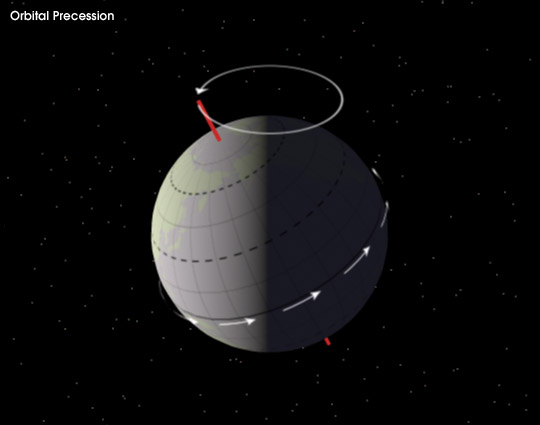![]()
Welcome to a special feature of StarChild! Each month we will feature a frequently asked question, with the answer.
Previous questions can always be found in our ARCHIVE.
![]()
|
The Earth spins on its "axis". This axis is an imaginary line running through the Earth. If you were to be high above the Earth, looking straight down along the axis, all the points on Earth would appear to move in circles around the axis. If you followed this axis out into space from the northern hemisphere on Earth, it would point toward a particular star in the sky. We call that star the "North Star" since it sits in the direction that the spin axis from the northern hemisphere of Earth points. At present, the star known as Polaris is the North Star. However, Polaris has not always been the North Star and will not always be the North Star. To understand that, we need to look at how the Earth spins on its axis. The spin axis of the Earth undergoes a motion called precession. If you have ever watched a spinning top, you know that its spin axis tends to stay pointed in the same direction. However, if you give it a slight nudge, the axis will start to change its direction, and its motion traces out a cone. This changing of direction of the spin axis is called precession. So what gave the Earth the "nudge" it needed to start precessing? The Earth bulges out at its equator, and the gravitational attraction of the Moon and Sun on the bulge provided the "nudge" which made the Earth precess. It was the ancient Greek astronomer and mathematician Hipparchus who first estimated the precession of the Earth's axis around 130 B.C. The period of precession is about 26,000 years. In other words, it takes 26,000 years for the axis to trace out the cone one complete time. |
|
|
So now you can see why Polaris will not always be aligned with the north spin axis of the Earth - because that axis is slowly changing the direction in which it points! Right now, the Earth's rotation axis happens to be pointing almost exactly at Polaris. But in the year 3000 B.C., the North Star was a star called Thuban (also known as Alpha Draconis), and in about 13,000 years from now the precession of the rotation axis will mean that the bright star Vega will be the North Star. Don't feel bad for Polaris, however, because in 26,000 more years it will once again be the Pole Star! By the way, there is not currently a star in the direction of the southern hemisphere spin axis. So we do not now have a "South Star". |
 |
| Watch an animation showing
the precession of Earth |
| Image and Animation by Robert Simmon, NASA GSFC |
![]()
The StarChild site is a service of the High Energy Astrophysics Science Archive Research Center (HEASARC), within the Astrophysics Science Division (ASD) at NASA/ GSFC.
StarChild Authors: The StarChild Team
StarChild Graphics & Music: Acknowledgments
StarChild Project Leader: Dr. Laura A.
Whitlock
Curator:
Responsible NASA Official: